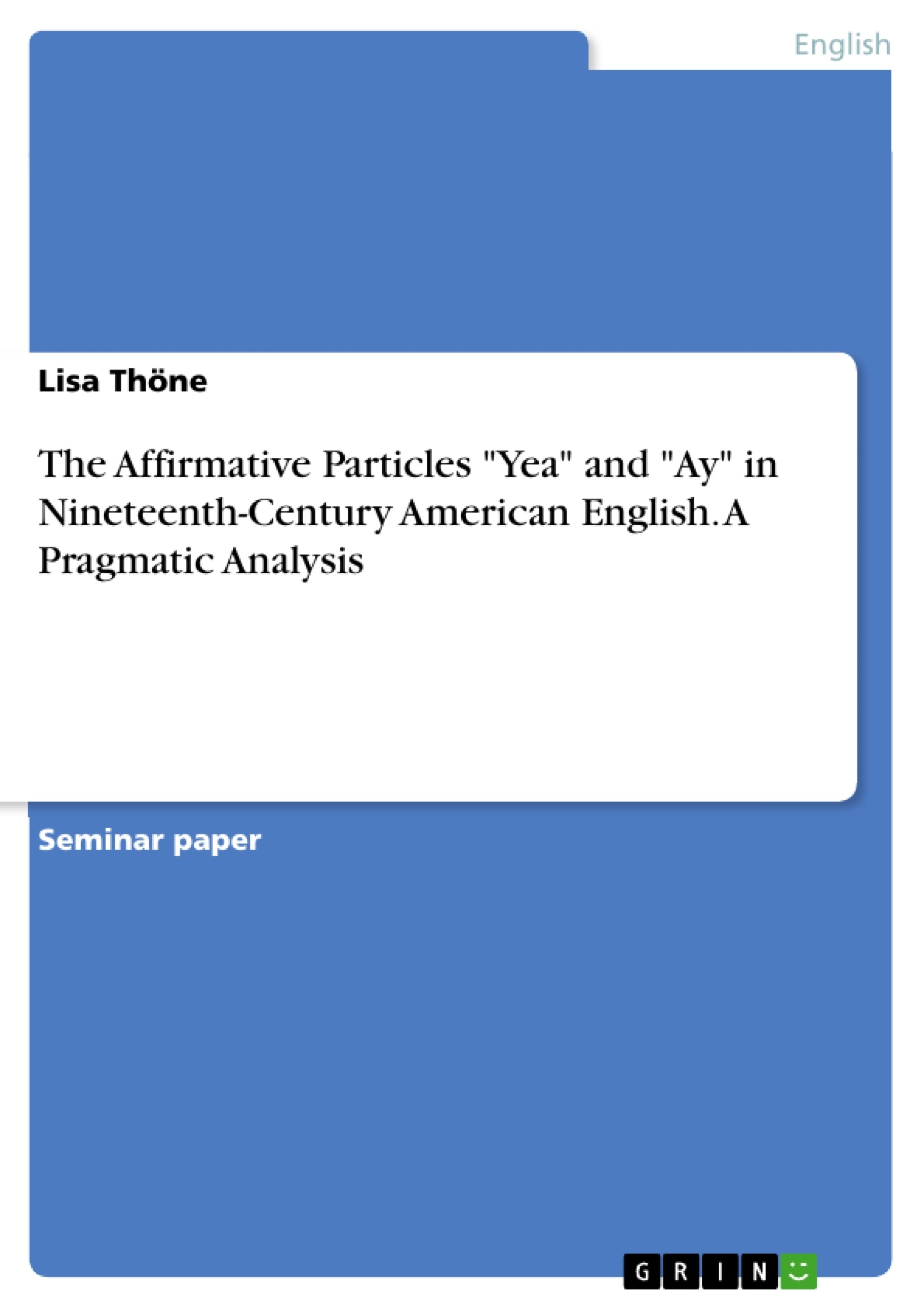This paper fills a gap in historical pragmatic research by examining the functions of the affirmative particles "yea" and "AY" in Nineteenth-century American English. The paper sheds light on usages and functions of "yea" and "AY".
During Late Modern English for instance, people have often prescribed communicative conventions that are associated with a particular educated and religious lifestyle that was desirable at that time at must be affirmed to. Therefore, tracing back the different functions but also forms of affirmative speech acts is of great importance. However, historical research on affirmative speech acts, especially on formal aspects concerning this type of speech act, is thin. Culpeper (2018) is the only scholar who researched affirmative particles in Early Modern English, particles that operate as key elements in affirmative speech acts since they convey agreement faster and more unambiguously than any other element in an affirmative speech act. To give an example, Culpeper showed among other things that during Early Modern English, yea was part of a Germanic speech pattern, being used after grammatically positively formulated questions.
Inhaltsverzeichnis (Table of Contents)
- 1. Introduction
- 2. Theoretical Background: Definitions and Previous Research
- 3. Analysis
- 3.1 Data and Methodology
- 3.2 Results
- 4. Discussion/Conclusion
- 4.1 Key Findings and Interpretations
- 4.2 Limitations and Suggestions for Further Research
- 5. Works Cited
- 6. Appendix
Zielsetzung und Themenschwerpunkte (Objectives and Key Themes)
This paper explores the functions of the affirmative particles "yea" and "AY" in Nineteenth-century American English, building upon previous research on affirmative speech acts in Early Modern English. It aims to investigate the diachronic development of these particles and their specific communicative contexts within the Late Modern English period. By combining corpus-analytical methods with a local grammar approach, the paper seeks to provide a comprehensive understanding of the evolution and usage of "yea" and "AY" in Nineteenth-century American English.
- Diachronic development of the affirmative particles "yea" and "AY" in Nineteenth-century American English
- Comparison of the usage of "yea" and "AY" to previous findings on Early Modern English affirmative particles
- Identification of sub-functions of "yea" and "AY" in their respective communicative contexts
- Analysis of the grammatical and content-related aspects of "yea" and "AY" in affirmative speech acts
- Exploration of the role of affirmative particles in shaping the dialogical and colloquial nature of written speech
Zusammenfassung der Kapitel (Chapter Summaries)
- Chapter 1: Introduction This chapter introduces the topic of affirmative speech acts and highlights the historical significance of tracing back the different forms and functions of these speech acts. It discusses the limited research on affirmative speech acts, particularly focusing on affirmative particles, and emphasizes the importance of analyzing the functions of "yea" and "AY" in Nineteenth-century American English. The chapter also presents the research questions and hypotheses that will guide the study.
- Chapter 2: Theoretical Background: Definitions and Previous Research This chapter provides definitions of affirmative particles and affirmative speech acts, drawing on existing linguistic literature. It then reviews Culpeper's (2018) research on affirmative particles in Early Modern English, highlighting the diachronic changes in usage and the specific functions of "yea" and "AY" in that period. The chapter also addresses potential pitfalls in previous research and discusses the importance of considering Shakespeare's influence on the English language.
- Chapter 3: Analysis This chapter details the data and methodology used in the research, including the corpus of Nineteenth-century American English texts and the combined corpus-analytical and local grammar approach employed. It presents the results of the analysis, focusing on the frequency and distribution of "yea" and "AY" across different sub-corpora. This chapter also examines the specific contexts in which these particles appear and explores potential sub-functions based on their collocational patterns.
Schlüsselwörter (Keywords)
This paper focuses on the affirmative particles "yea" and "AY" in Nineteenth-century American English, analyzing their diachronic development, communicative functions, and sub-functions within the context of Late Modern English. Key concepts include affirmative speech acts, corpus linguistics, local grammar, collocational patterns, and diachronic change. The research builds upon and expands previous findings on the use of affirmative particles in Early Modern English, offering insights into the evolution of these particles and their significance in shaping the development of the English language.
- Arbeit zitieren
- Lisa Thöne (Autor:in), 2023, The Affirmative Particles "Yea" and "Ay" in Nineteenth-Century American English. A Pragmatic Analysis, München, GRIN Verlag, https://www.grin.com/document/1475443



